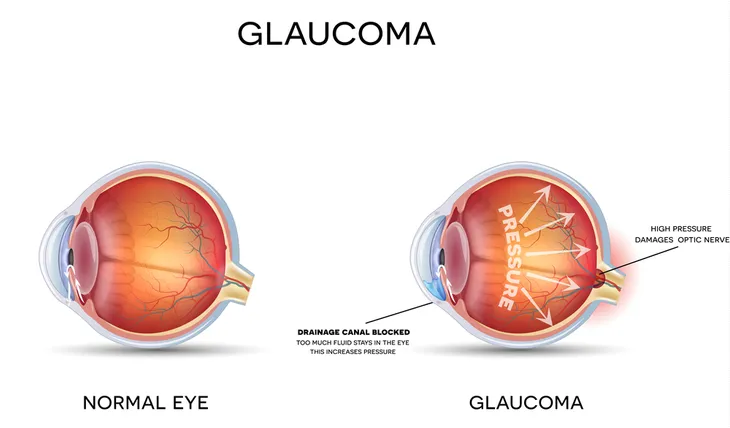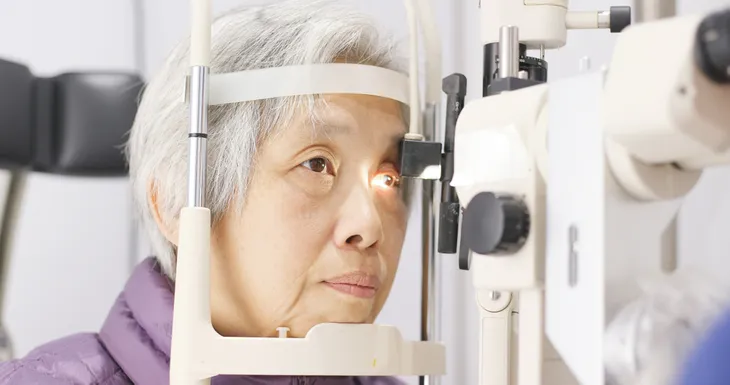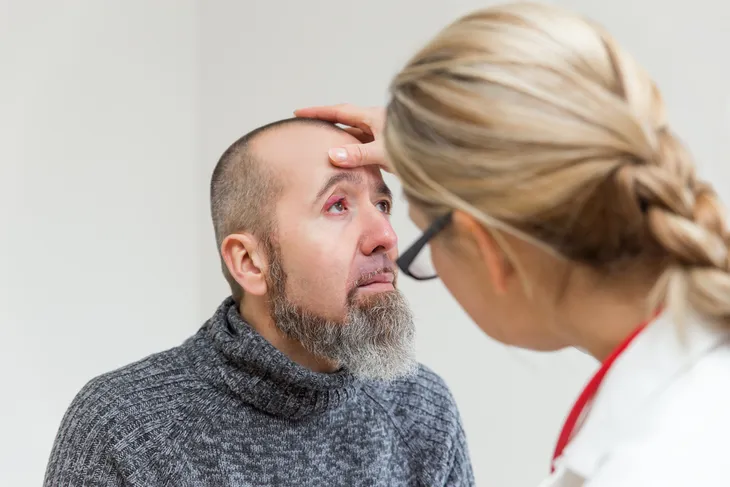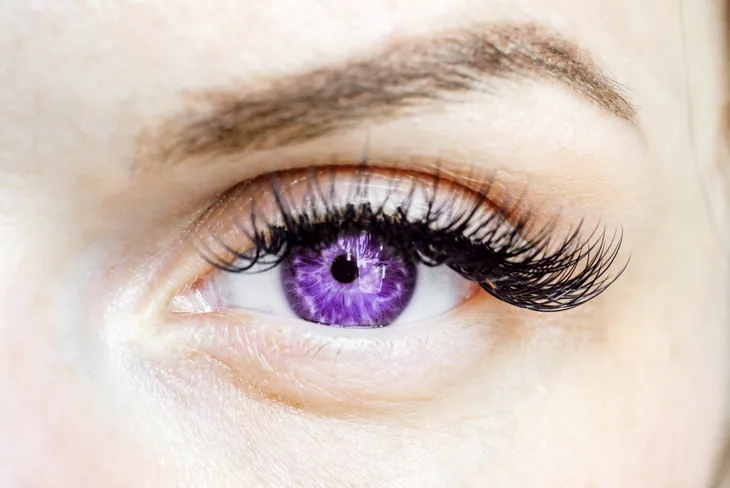Our eye color comes from the iris, that colored ring around the pupil which filters light into the eye. The color of our eye is determined by the presence of a protein called melanin which also determines hair and skin color.
Almost all babies are born with brown eyes, even if they don’t stay that way forever. Eventually before the end of infancy, our eye colors mature into what they will naturally be whether that is blue, green, brown, hazel, green, or even gray!
However, there are some cases where eye color can change later in life. It all sounds very sci-fi and strange, but it does happen. In fact, nowadays it’s not uncommon for people to change their eye color either through cosmetic surgery or with colored contacts. When it happens naturally, there’s usually a perfectly good scientific explanation for it, and it’s often a result of an underlying health or medical issue.
So without further ado, here are all the health-related reasons someone’s eye color might change…
1. Newborn Eye Color
While this isn’t necessarily a health condition, it’s a big eye color change and as promised, there’s a scientific reason to explain it. As we previously mentioned, most babies are born with the same brown eye color and that is because the melanin, which is responsible for determining eye color, comes from special cells called melanocytes. These melanocyte cells create melanin when needed and will respond to light (hence why our skin becomes darker when it’s exposed to the sun). “The melanocytes in the eyes of newborns have never been exposed to light, so they haven’t become fully active,” writes Healthline.
It doesn’t matter what their race, gender, or skin color is, all babies are all born with brown eyes. (However, some Caucasian babies can be born with blue or gray eyes). “As melanocytes are activated by light over an infant’s first year of life, eye color may change. Typically, this means turning from a blue/gray (low melanin) to hazel/green (medium melanin), or to brown (high melanin).”
2. Heterochromia
You would definitely know if you’d met someone with heterochromia because it’s hard to miss when someone has two different colored eyes! We’re talking something like one blue eye and one brown eye, but it can get even more complex than that. These people can also have one part of their eye be a different color than the other! “It’s also possible for small segments of the same iris to be different colors. For example, half of your left eye could be blue and half could be brown,” says Healthline. Sometimes referred to as heterochromia iridis and heterochromia iridum, this condition has been around long before there were ever cosmetic colored lenses.
Unlike other conditions on this list, most of the time heterochromia is not serious. It’s not a result or symptom of any underlying medical issues. It’s just a genetic fluke and in very rare cases it can be “a sign of a congenital (present from birth) condition or the result of an injury or illness.”
3. Fuchs Uveitis Syndrome
This one is a mouthful. Fuchs uveitis syndrome is sometimes referred to as Fuchs heterochromic uveitis and Fuchs heterochromic iridocyclitis. The name comes from a doctor named Ernst Fuchs who first named the condition back in 1906 after meeting a patient with two different colored eyes. According to Healthline, he believed inflammation played a role in why this happened.
We now know today that it’s a condition that often only affects one eye and causes inflammation in the uvea, located in the middle of the eye. This is the same place as the iris and other important structures. “This typically leads to lightening of the iris of the affected eye, although in some cases the condition causes iris darkening. The end result is a difference in eye color between the eyes, or heterochromia,” explains LiveStrong.
People who suffer from fuchs uveitis syndrome are at a higher risk for developing glaucoma and cataracts, says LiveStrong.
4. Pigmentary Glaucoma
Glaucoma is an umbrella term that sums up a group of eye conditions affecting the optic nerve. These conditions are quite serious as they can cause vision loss and in some cases blindness. It occurs when fluid moves in and out of the tiny chamber at the front of the eye. “Fluid moves in and out of this chamber, nourishing the tissue there. This fluid flows out of the eye through a spongy meshwork that acts like a drain,” says Healthline.
Pigmentary glaucoma results after someone develops pigment dispersion syndrome. It affects the pigment in the iris and causes the loose pigment granules to collect in the front chamber of the eye. “With pigmentary glaucoma, these pigment granules block normal fluid flow through the front chamber of the eye. This causes glaucoma, wherein increased pressure in the eye can lead to vision loss,” says LiveStrong. “The dispersion of pigment from the iris can cause eye color changes, and the two eyes may be different colors if they are affected unequally.”
The symptoms of pigmentary glaucoma are similar to glaucoma, but can also cause peripheral vision loss which makes it hard to see out of the side of the eyes. Anyone suffering from glaucoma needs to see a specialist and have it carefully managed by an ophthalmologist or optometrist.
5. Horner Syndrome
Horner syndrome is caused by a disruption in the nerve pathways from the brain, to the face, and then the eye. LiveStrong describes it as “a triad of symptoms caused by impairment of specific fibers in the third cranial nerve that innervate the eye and face.” It usually develops as a result of another medical problem like a stroke, tumor, or spinal cord injury, says Mayo Clinic.
Horner syndrome results in a number of different symptoms, including “decreased pupil size, a drooping eyelid and decreased sweating on the affected side of your face,” writes Mayo Clinic. But LiveStrong points out that if it occurs prior to a child’s 1st birthday it can affect the color of their eyes. The source goes on to explain that the iris in the affected eye can become lighter in color than the other, and in some rare cases “a difference in eye color may also occur in acquired Horner syndrome in adults, although this is rare.”
6. Tumors of the Iris
You’ve already heard us talk about the iris as the colored ring around the pupil. Unfortunately, even thought it seems unreachable by cancer, it’s not. Tumors can growth either within or behind the iris. “Most iris tumors are cysts or pigmented growths (like moles), but some are malignant melanomas (a form of aggressive, life-threatening cancer),” writes Healthline.
Most of the time people who have a tumor on or behind their iris won’t have any symptoms. “Sometimes, though, changes in the eye’s appearance can be seen. Thick, pigmented spots called nevi can change, grow larger, or pull the pupil in a different direction,” explains Healthline. Anyone with an eye tumor needs to seek medical attention right away, so if you suspect this is what’s wrong, consult with a specialist to determine if that’s the case. An eye cancer specialist will be able to determine whether it’s melanoma and if treatment is needed. According to the source, cancer treatment will involve either radiation or surgery.
7. Diet
There are sources on the internet that list diet as a reason for eye change, particularly a raw vegan diet. While it’s true, our diet can have a lot of different effects on our health and even cause some kinds of medical conditions, there is no science or research to back up any of these claims that eye color can change due to dietary choices, says Healthline.
Even though there’s no evidence that the food we eat can change our eye color, there is lots of evidence that our diet can improve or help maintain our eyesight! Check out this article on all the foods that are good for our eyes.
8. Medication
Many of the medications prescribed to treat health conditions come with a long list of other side effects. Apparently if you’re already taking medication for glaucoma, be warned that it can cause a change in eye color. LiveStrong points out that particular medications to be wary of for this are latanoprost (Xalatan) and bimatoprost (Lumigan) drops. These are prescriptions to treat “lower internal eye pressure in people with glaucoma can cause darkening or light-colored eyes due to an increased amount of pigment in the iris,” writes the source.
Another medication that can have a similar effect is bimatoprost (Latisse). This medication is applied to the upper eyelid margin and is used to enhance eyelash growth for cosmetic purposes. Users should be warned that any “darkening of the irises due to these medications may be permanent.”
9. Aging
While it’s quite rare, for some people, eye color can still change after infancy. This doesn’t happen often and it is most commonly seen in people of Caucasian heritage, says LiveStrong. A study from May 1997, which was published in “JAMA Ophthalmology,” found that “10 to 15-percent of white children experienced subtle changes in eye color after age 6 and into early adulthood.”
The researchers also noted that these late changes are typically only seen in people of a certain genetic disposition, so it’s likely passed down through family history. Also, “people with dark colored irises are less likely to experience noticeable eye color changes compared to people with light color irises,” writes LiveStrong.
10. Other Causes
If eye color change isn’t due to any of the other reasons already listed in this article, LiveStrong states that it could be due to a traumatic eye injury. Prevention also notes that things like allergies, cancer, and liver problems can cause changes to the eye. If you notice that the whites of your eyes are turning red, and maybe are even itchy or dry, it could be due to undiagnosed allergies. If the whites of the eyes are turning yellow, this could be linked to something more serious like liver problems. The source also goes on to say that if just one eye color changes it could be a signal of melanoma of the iris, says Rachel Bishop, MD, chief of the consult service section of the National Eye Institute to the source.
11. Myth of Alexandria’s Genesis
We put this one at the bottom because even though it’s been circulating around on the internet since 2005, it’s not true. According to Healthline, Alexandria’s Genesis is an “internet myth about perfect human beings whose eyes turn purple during infancy.” Many of the stories involve a child being born with purple eyes or that their eyes turn purple shortly after birth. Even though it sounds pretty cool, it’s definitely not true.
So where did this odd myth come from? The source goes on to say that it originated from several different stories and it gets even stranger. These stories also state that children born with “Alexandria’s Genesis” will have “pale skin and well-proportioned bodies that don’t gain weight. These perfect humans supposedly live to be well over 100 years old and produce very little body waste,” says Healthline.
12. When to See a Doctor
Now back to reality, if you’ve noticed any seriously dramatic change to eye color in either one or both eyes, you should consult with a doctor to determine what the reason is behind this cause. It could be due to any of the health conditions we listed above. LiveStrong warns that if these changes are also associated with other symptoms like eye pain, redness, blurred or limited vision then you should seek medical attention right away.















